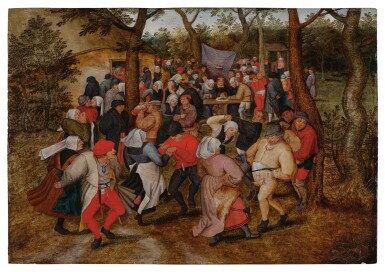Master Paintings
Master Paintings

Property from an Important Private Collection
Pieter Brueghel the Younger
The Wedding Dance
Auction Closed
May 22, 04:23 PM GMT
Estimate
800,000 - 1,200,000 USD
Lot Details
Description
Property from an Important Private Collection
Pieter Brueghel the Younger
Brussels 1564 – 1637/8 Antwerp
The Wedding Dance
signed lower left: P. BREVGHEL.
oil on panel, the reverse branded with Antwerp's coat of arms and the panel maker's mark of Michiel Vrient (act. 1615 - 1637)
panel: 15 ¾ by 23 in.; 40.0 by 58.4 cm.
framed: 22 ½ by 29 ¼ in.; 57.2 by 74.3 cm.
De Vilegas collection, Belgium;
With Galerie de Jonckheere, New York, circa 1997;
From whom acquired by the present collector.
The Wedding Dance typifies Pieter Brueghel the Younger’s fascination with depicting rural life in the Low Countries. An iconic representation of rustic merry-making that combines landscape and genre, the scene was among the artist’s most successful compositions, one often repeated by Brueghel and his workshop. A celebration of the simple pleasure derived from dancing among friends, the painting epitomizes the type of scene popularized by the Brueghel dynasty.
An uninhibited spirit of warmth and joviality suffuses the composition, which captures all manner of carousing. The pathos-imbued depiction of bawdiness focuses on four couples who dance in the foreground accompanied by two bagpipers at right. Behind the eight dancers, other wedding guests embrace, imbibe, and cavort, their exuberance almost overshadowing the happy couple. The bride, distinguished by her flowing locks and the simple crown hanging above her (denoting her as “queen for the day”), sits before a lilac cloth of honor. Two bonneted women—perhaps her mother and mother-in-law—flank her as one of the attendees places a silver coin on a platter. The bridegroom’s identity remains difficult to ascertain.
Like many of Pieter Brueghel the Younger’s works, The Wedding Dance is part of a pictorial tradition established by his father, Pieter Bruegel the Elder. Indeed, the composition derives from an untraced drawing or painting produced by the latter, known from an engraving by Pieter van der Heyden that was published by Hieronymus Cock (Metropolitan Museum of Art, 33.52.29). Two versions, both signed and dated 1607, in the Walters Art Gallery, Baltimore, and the Musées Royaux des Beaux-Arts, Brussels, are the earliest of Brueghel the Younger’s treatments of the subject. The present painting, like the majority of autograph versions, seems to derive directly from Brueghel the Elder’s lost work rather than the print, which is rendered in reverse.
The frankness of both subject matter and formal expression conveys an exaltation of modesty. The countryfolk are simply modelled, their facial features, gestures, and poses rendered without idealization. And their livelihoods (and liveliness) derive from the lands of the Low Countries themselves, imbuing the image with a certain agrarian idealism. Yet beneath the light-hearted image lurks a moralizing message: the loss of corporeal control, in the form of both dancing and more amorous pursuits, poses a threat to the pursuit of a virtuous life.
You May Also Like










